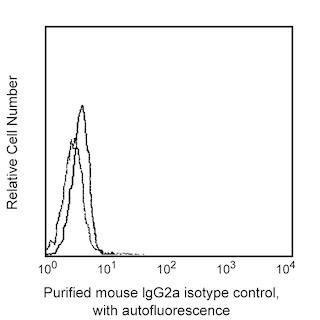-
Your selected country is
Middle East / Africa
- Change country/language
Old Browser
This page has been recently translated and is available in French now.
Looks like you're visiting us from {countryName}.
Would you like to stay on the current country site or be switched to your country?




Flow cytometric analysis of CD11a expression on human peripheral blood lymphocytes. Human whole blood was stained with either Purified Mouse Anti-Human CD11a (Cat. No. 555378; solid line histogram) or Purified Mouse IgG2a, κ Isotype Control (Cat. No. 555571; dashed line histogram), followed by FITC Goat Anti-Mouse IgG/IgM (Cat. No. 555988). Erythrocytes were lysed with BD Pharm Lyse™ Lysing Buffer (Cat No. 555899). Fluorescent histograms were derived from gated events with the side and forward light-scattering characteristics of intact lymphocytes.


BD Pharmingen™ Purified Mouse Anti-Human CD11a

Regulatory Status Legend
Any use of products other than the permitted use without the express written authorization of Becton, Dickinson and Company is strictly prohibited.
Preparation And Storage
Product Notices
- Since applications vary, each investigator should titrate the reagent to obtain optimal results.
- An isotype control should be used at the same concentration as the antibody of interest.
- Caution: Sodium azide yields highly toxic hydrazoic acid under acidic conditions. Dilute azide compounds in running water before discarding to avoid accumulation of potentially explosive deposits in plumbing.
- Sodium azide is a reversible inhibitor of oxidative metabolism; therefore, antibody preparations containing this preservative agent must not be used in cell cultures nor injected into animals. Sodium azide may be removed by washing stained cells or plate-bound antibody or dialyzing soluble antibody in sodium azide-free buffer. Since endotoxin may also affect the results of functional studies, we recommend the NA/LE (No Azide/Low Endotoxin) antibody format, if available, for in vitro and in vivo use.
- Please refer to www.bdbiosciences.com/us/s/resources for technical protocols.
Companion Products





.png?imwidth=320)
The G43-25B monoclonal antibody specifically binds to CD11a. CD11a is the 180 kD integrin α chain which associates with CD18 (integrin β2) to form the heterodimer glycoprotein CD11a/CD18. This is known as the lymphocyte function associated antigen-1 (LFA-1), which is on all leukocytes; and is an adhesion molecule involved in lymphocyte and granulocyte functions. LFA-1 mediates adhesion of lymphoid cells to the vascular endothelium in association with its ligand, the intracellular adhesion molecule-1 (ICAM-1), CD54. Other ligands are ICAM-2 (CD102) and ICAM-3 (CD50).
Development References (3)
-
Dustin ML, Springer TA. Lymphocyte function-associated antigen-1 (LFA-1) interaction with intercellular adhesion molecule-1 (ICAM-1) is one of at least three mechanisms for lymphocyte adhesion to cultured endothelial cells. J Cell Biol. 1988; 107(1):321-331. (Biology). View Reference
-
Dzionek A et al. BDCA-2, BDCA-3, and BDCA-4: three markers for distinct subsets of dendritic cells in human peripheral blood.. J Immunol. 2000; 165(11):6037-6046. (Clone-specific). View Reference
-
Rothlein R, Dustin ML, Marlin SD, Springer TA. A human intercellular adhesion molecule (ICAM-1) distinct from LFA-1. J Immunol. 1986; 137(4):1270-1274. (Biology). View Reference
Please refer to Support Documents for Quality Certificates
Global - Refer to manufacturer's instructions for use and related User Manuals and Technical data sheets before using this products as described
Comparisons, where applicable, are made against older BD Technology, manual methods or are general performance claims. Comparisons are not made against non-BD technologies, unless otherwise noted.
For Research Use Only. Not for use in diagnostic or therapeutic procedures.
Report a Site Issue
This form is intended to help us improve our website experience. For other support, please visit our Contact Us page.